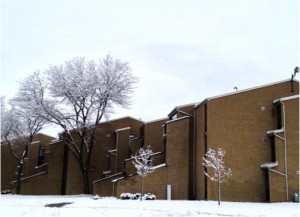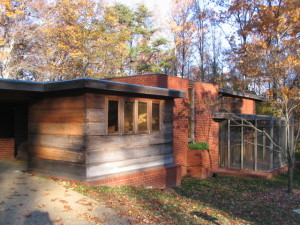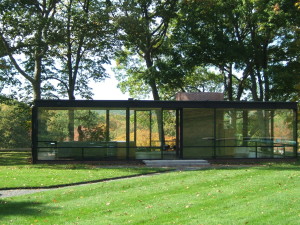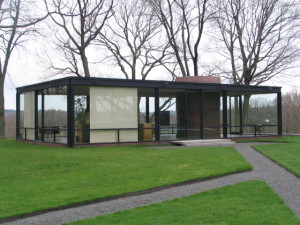
Brasilia, the capital of Brazil, is a modern masterpiece of town planning and Brazil’s specific type of modernism designed by Oscar Niemeyer and Lucio Costa. Photo copyright UNESCO.
It’s been three years since I launched Barbara A. Campagna/Architecture + Planning, PLLC and while many things have changed, my goal to work on “greening what’s already here” continues to be met, often in places I never expected. Many people are finding new ways to integrate historic preservation and green building practices, which makes my new venture a delightful and intellectually inspiring one. This is blog three of my anniversary week.
The Sustainability of Modern Heritage

The Shoreline Apartments in Buffalo, NY were designed by Paul Rudolph and built from 1972-1974. They are currently threatened with partial demolition.
A topic I’ve been spending more and more time on is the sustainability of modern heritage. In the past six months I’ve been teaching a graduate seminar on “Preserving Modern Heritage,” spoke about controlling humidity in modern architecture at the Docomomo US annual conference in Houston and was invited to speak at Greenbuild Brazil on this same topic in August. While many of our traditional buildings are inherently green, many of our modern heritage buildings (sites from the early twentieth century to 1975) appear to be inherently “less green”. Almost 60% of our building stock was built in this period and these buildings were typically the most energy-inefficient ever built. These are the buildings that may be the biggest contributors to climate change. If we want to manage climate change, we need to address these buildings. As we begin to acknowledge the significance of modern heritage and look to ‘green’ sites from that era, we find ourselves confronting questions and developing solutions reqarding authenticity, building fabric and energy efficiency that in many cases are the exact opposite of how we approach our traditional buildings. We are entering new territory with these buildings.
Preserving and greening modern heritage presents architects, engineers and preservationists with exciting challenges and fundamental dilemmas. What are the aspects of modernism that make it one of the most difficult periods to evaluate and retrofit? These aspects include questions of authenticity, the use of experimental materials and techniques such as glass curtain walls and concrete panels, the use of hazardous and toxic materials like lead and plate glass, the ability to build disposable buildings and materials, the construction of the largest buildings and complexes ever built, and maintaining some of the most energy inefficient buildings ever built.

The Pope-Leighey House, a Usonian house designed by Frank Lloyd Wright, and currently located in Alexandria, VA after two moves, was designed originally in 1940 with many passive design features.
According to the Department of Energy Study on commercial buildings in 2003, the most energy efficient commercial buildings in the country were built before 1920 and after 1990, which would lead us to surmise that the most inefficient buildings in the country were built in the years in between. And given the fact that 85% of our commercial building portfolio in the United States was built after 1945, the assumption can then easily be made that buildings from the modern era are the biggest problem we have from a climate change standpoint. Many would like you to think they’re also the biggest problem we have in terms of aesthetics. Not only culturally, but also physically, the distance between past and present has become ever shorter, making preservation efforts increasingly more urgent while at the same time appearing far more dramatic because they are often experienced within the same generation as a building’s construction.
Modern Challenges
Do we need more time to appreciate buildings of our own recent past? We will be confronting these challenges more and more as our building stock ages. Some of the key themes include:
Experimental Materials & Assemblies:

The Philip Johnson Glass House in New Canaan, CT, designed in 1949 by Philip Johnson is one of the world’s modern icons. The replacement of the original plate glass has long been a topic of conversation.
Glass curtain walls, precast wall and ceiling systems, concrete structure and panels – all have one thing in common – they were experimental materials and assemblies. The excitement of designing and building something completely new often superseded the rigorous research needed to confirm the longevity of these materials. Now, decades later, they may be crumbling and impossible to restore. Should we be forced to replace them in kind when they never worked or can we redesign and reinstall replacements that will work better but might look differently?
Sealing Buildings with Curtain Walls:

The Farnsworth House in Plano, IL, designed by Ludwig Mies van de Rohe and opened in 1951, has one operable hopper window and one door on opposite ends of one another.
In this same period we seemed to decide as a culture that operable windows were old fashioned and unnecessary. So we started hermetically sealing our buildings, and installing curtain walls and windows that couldn’t open. How do we remake these features so that they improve our energy use, controllability and comfort but do not endanger the historic integrity of the buildings?
Hazardous & Dangerous Materials:
Hand in hand with experimental materials went materials that were dangerous and toxic. Floor tiles made with asbestos. Curtain walls out of plate glass. Sealants with asbestos and sometimes lead. The list goes on. Should we be restoring dangerous materials such as plate glass?
Disposable Approach to Construction:
It was all about excess during this era. Why build a building to last when we could just replace it when we tired of it? While most of the primary resources at our historic sites were built to last, that does not mean we may not encounter other resources at current or future sites that just were not built to last.

The Glass House was designed with a radiant heating system and no air conditioning. The house is ventilated and cooled in warm weather by opening the doors on each of its four sides and lowering the shades as the sun hits the building.
While many of these questions suggest that modern heritage is unsustainable, more and more research is showing that many of our modern buildings actually were built with passive design features and sustainable approaches. Future research and case studies will start to dispel the fact that all modern heritage is unsustainable. It’s how we manage and maintain these buildings in many respects that is the culprit.
And if you’d like to “subscribe” or follow my blog, True Green Cities, please sign up through the “Subscribe” button at the bottom left of this page. You’ll receive a daily recap when new blogs are posted. Or Sign up for the Feed.
